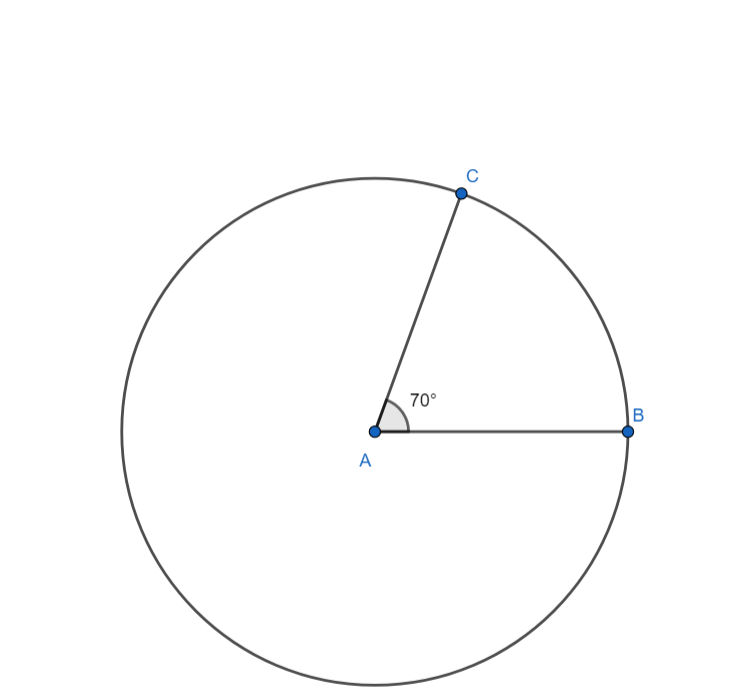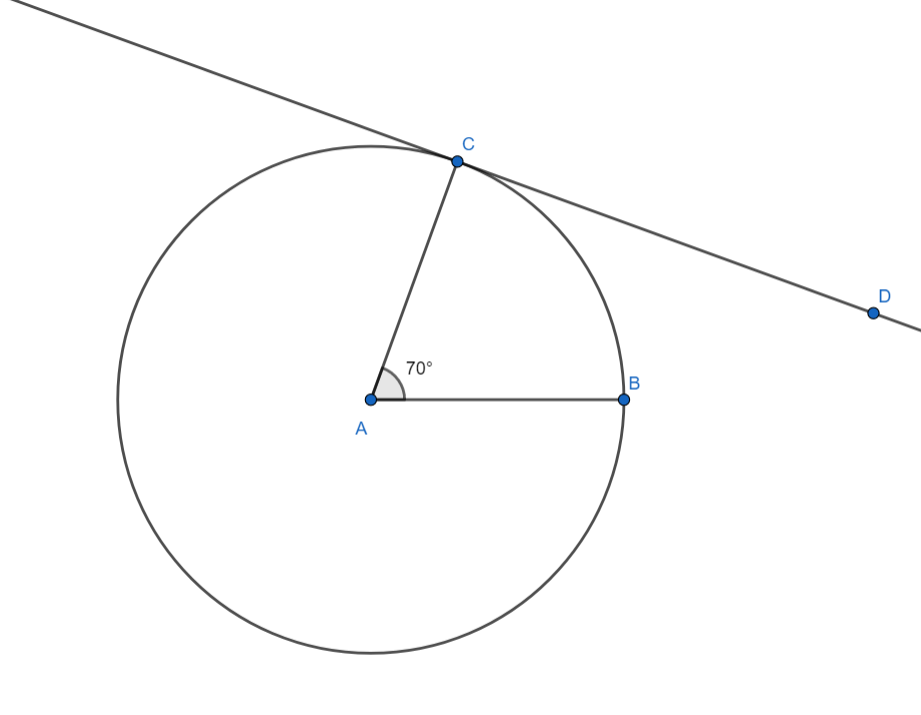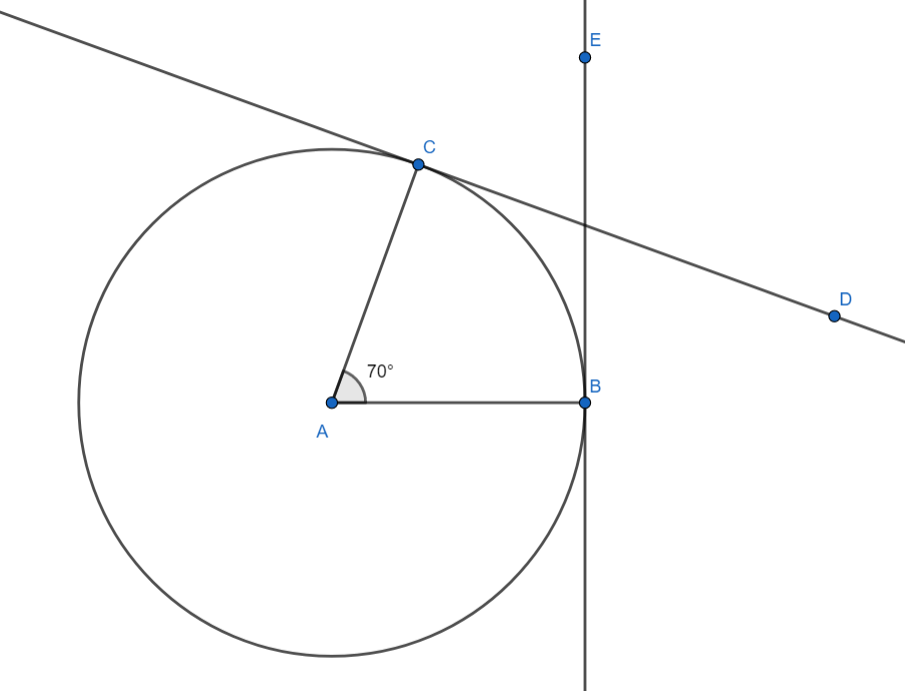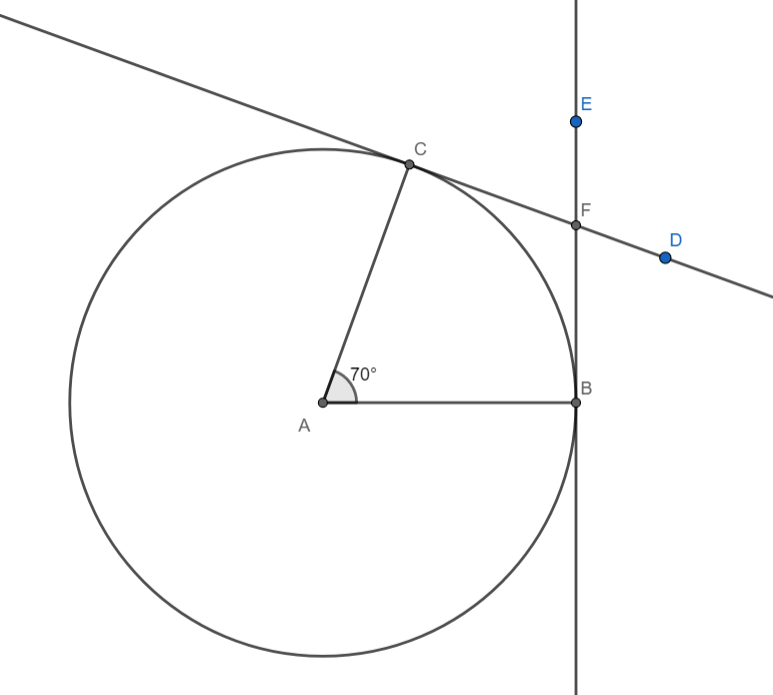
In a circle of radius 4.5cm draw two radii such that the angle between them is $70{}^\circ $. Construct tangents at non-centre ends of the radii.
Answer
581.1k+ views
Hint: Draw a circle of radius 4.5cm. Now drawn any radius of the circle and draw an angle of measure $70{}^\circ $ with the radius drawn. Hence draw the radius making an angle of $70{}^\circ $ with the previously drawn radius. Now draw two perpendicular lines to these two radii at non-centre points. Hence draw two tangents to the circle.
Complete step by step solution:
Steps of construction:
[1] Mark point A on paper. With A as centre and radius, AB = 4.5cm draw a circle.

[2] On the line segment AB draws an angle CAB $70{}^\circ $.

[3] CA and AB are the radii of the circle at an angle of $70{}^\circ $ with each other.
[4] Through C draw a line DC perpendicular to the radius AC.

[5] Through B draw a line BE perpendicular to the radius AB

[6] Hence the lines DC and EB are the required tangents to the circle

Note: Justification of Construction:
We know that the tangent to a circle and the radius of a circle are perpendicular to each other at the point of contact.
Since AC and DC are perpendicular to each other and AC is the radius of the circle and C the point of contact, DC is a tangent to the circle.
Since AB and EB are perpendicular to each other, and AB is the radius of the circle and B the point of contact, EB is a tangent to the circle.
Hence EB and DC are tangents to the circle on the non-centric points of radii which are at an angle of $70{}^\circ $ with each other.
Verification of correctness of the construction:
We know that the points of contact, the centre of the circle and the point of intersection of tangents are concyclic with the midpoint of the line joining the point of intersection of the tangents with the centre as the centre of the circle. Hence draw a perpendicular bisector of the line segment FA and let it intersect FA at G. With G as centre and radius GA draw a circle and verify it passes through all points A,B,C and F.
Hence our construction is verified to be correct.
Complete step by step solution:
Steps of construction:
[1] Mark point A on paper. With A as centre and radius, AB = 4.5cm draw a circle.

[2] On the line segment AB draws an angle CAB $70{}^\circ $.

[3] CA and AB are the radii of the circle at an angle of $70{}^\circ $ with each other.
[4] Through C draw a line DC perpendicular to the radius AC.

[5] Through B draw a line BE perpendicular to the radius AB

[6] Hence the lines DC and EB are the required tangents to the circle

Note: Justification of Construction:
We know that the tangent to a circle and the radius of a circle are perpendicular to each other at the point of contact.
Since AC and DC are perpendicular to each other and AC is the radius of the circle and C the point of contact, DC is a tangent to the circle.
Since AB and EB are perpendicular to each other, and AB is the radius of the circle and B the point of contact, EB is a tangent to the circle.
Hence EB and DC are tangents to the circle on the non-centric points of radii which are at an angle of $70{}^\circ $ with each other.
Verification of correctness of the construction:
We know that the points of contact, the centre of the circle and the point of intersection of tangents are concyclic with the midpoint of the line joining the point of intersection of the tangents with the centre as the centre of the circle. Hence draw a perpendicular bisector of the line segment FA and let it intersect FA at G. With G as centre and radius GA draw a circle and verify it passes through all points A,B,C and F.
Hence our construction is verified to be correct.
Recently Updated Pages
Why is there a time difference of about 5 hours between class 10 social science CBSE

Master Class 12 Business Studies: Engaging Questions & Answers for Success

Master Class 12 Economics: Engaging Questions & Answers for Success

Master Class 12 English: Engaging Questions & Answers for Success

Master Class 12 Maths: Engaging Questions & Answers for Success

Master Class 12 Social Science: Engaging Questions & Answers for Success

Trending doubts
Who was the first woman to receive Bharat Ratna?

State and prove the Pythagoras theorem-class-10-maths-CBSE

State BPT theorem and prove it class 10 maths CBSE

What is the minimum age for fighting the election in class 10 social science CBSE

Describe the Salient Features of Indian Economy

The slogan Jai Hind was given by A Lal Bahadur Shastri class 10 social science CBSE




